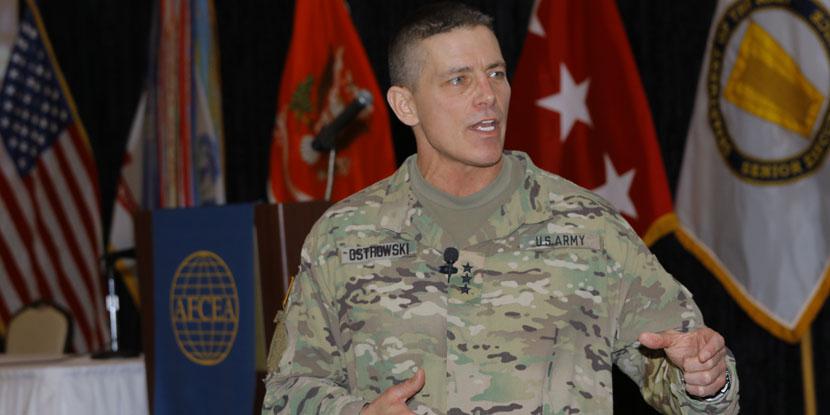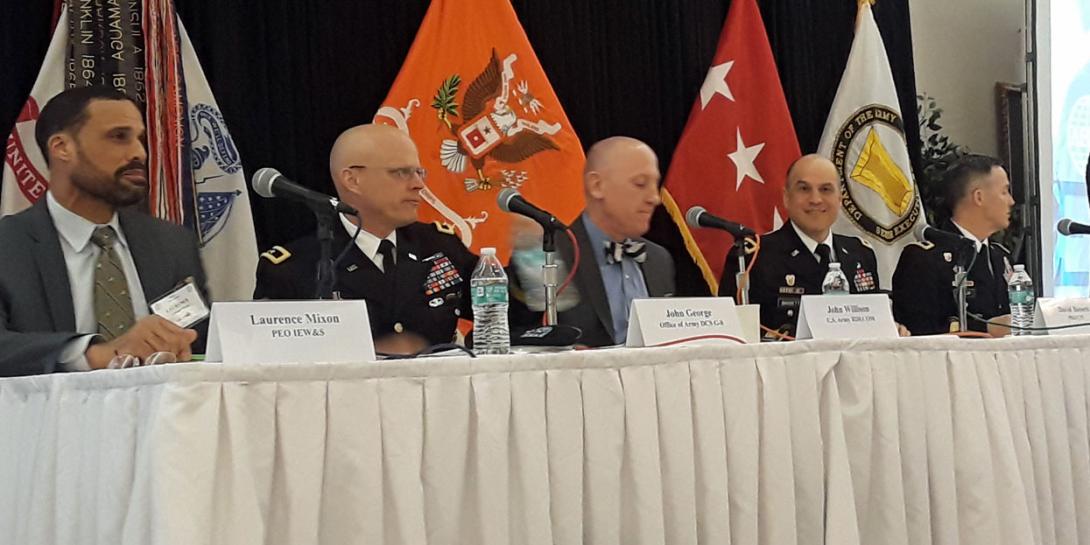Army Aims for Agile Acquisition of Offensive Cyber Weapons
U.S. Army officials are applying a streamlined acquisition process known as an IT box to offensive cyber technologies.
The IT box acquisition concept includes four sides: developing the capabilities requirement, determining development costs, analyzing sustainment and operations costs, and providing oversight and management of the product.
Maj. Gen. John George, USA, force development director, Office of the Army Chief of Staff G-8, told the the AFCEA Army Signal Conference in Springfield, Virginia, that the Army is focusing on the IT box concept pretty heavily.
“What it means is that we can define a requirement and bound it by resources and simply over a five-year time period say we are going to spend X amount of dollars, we’re going to spend X amount of dollars annually, [we] cannot exceed those resources, and we establish the limit of capabilities that we want to provide. Then inside of that box of resources, [we] can deliver incremental improvements and capabilities through capability drops,” Gen. George explained.
He added that the capability drops and other requirements that are “falling inside that box” are being delegated down to a lower level. “That allows us to move with speed, but it is also a matter of trust from our senior leaders,” he said.
MG John George, The Army is in a different place now than it was a couple of years ago. We are aligning with the National Defense Strategy.@AFCEA
— George Seffers (@gseffers) March 7, 2018
So, for example, some requirements have been delegated down to Army Cyber Command and the Cyber Center of Excellence. “It’s allowing the team to move faster, but they’re staying within the parameters that were established by the senior leadership of the Army in terms of resources and in terms of capabilities that they’re going to deliver,” Gen. George reported.
Laurence Mixon, special assistant to the Program Executive Office, Intelligence, Electronic Warfare and Sensors, said the concept is being applied to offensive cyber capabilities. “We’re looking into that heavily in the offensive cyber arena to allow us to continue to … adapt and generate new capabilities. That is the way we should work in many areas in the future,” he said.
The IT box concept is one piece of a massive effort to modernize the Army’s network in the coming years. The service has determined its current network, which was largely pieced together through urgent operational needs over 16 years of war in Iraq and Afghanistan, is too complex and too vulnerable against peer or near-peer adversaries. As a result, Army officials are pushing hard to adopt cutting-edge technologies.
That modernization push, which will really take off in a few years following a focus on current force improvements and sustainment, includes experimentation. “We are experimenting out the wazoo. We are [deploying] prototype systems to units in the field to do some hands-on testing and evaluation,” Mixon said, adding that those soldiers are “breaking things” and “figuring things out” and informing the requirements and development processes.
Mixon noted that the service has gotten behind on electronic warfare capabilities and said, “We’re going to keep working that space and resurrect tactical EW in the United States Army.”
Gen. George said the modernization is aided in part by a reinvigorated Army Requirements Oversight Council (AROC), which is playing a greater role than it has in years past. “The AROC is a synchronization and integration function that synchronizes requirements, acquisition and resources and is doing that along with the test community to make sure we are adequately testing along a timeline and at a cost that allows us to deliver capabilities faster,” he stated. “It’s a pretty important to the way that we’re going to do business.”
Network modernization also includes a complete rethinking of some major programs known as programs of record. “We’re not really thinking about them as programs of record but as standards of record,” Gen. George explained. He compared the approach to that of building a highway, which requires the establishment of and adherence to certain rules. “Those who want to keep their cars, trucks and other vehicles on the highway had better understand what those standards are. They’re going to have to adhere to the standards, and we’ll have to have them policed and enforced,” he added.
MG George, @USArmy, We're thinking about programs differently, not programs of record but standards of record. I think of it as building a highway, establishing rules about who can ride on it. To be on the highway, have to understand what the rules are.#AFCEA
— George Seffers (@gseffers) March 7, 2018
The modernization push also requires the Army to stop investing in some programs, such as the Warfighter Information Network-Tactical (WIN-T), which did not fare well in a recent assessment. Maj. Gen. David Bassett, USA, program executive officer for command, control and communications-tactical, reminded the audience the service will stop investing heavily in WIN-T after the 2018 fiscal year, but the system will remain in some units for several years to come. “It’s really about what technology is available that we can insert into that architecture over time to improve the simplicity, the capability, the throughput, the configuration.”
John Willison, deputy to the commanding general, U.S. Army Research, Development and Engineering Command, said modernizing the network is more challenging that the Army’s other modernization goals, which include long-range precision fires, next-generation combat vehicles, future vertical lift, air and missile defense, and soldier lethality.
The network is more challenging in part because of the interdependencies. In addition, expectations for a modern network can sometimes be unrealistic, he noted. “Everyone with an iPhone is an expert, so the expectations can be pretty high as far as what people want and what they think they can get,” Willison declared.
He added that the Army will triple its science and technology investments in networking technologies in the coming years. Those investments include satellite communications, resilience against the threat and various forms of artificial intelligence. “We’re putting most of our investment from an S&T perspective into intelligent networking," Willison said. "We don’t want complexity to be the user’s problem. We’ve got to be able to build intelligence into the network to let the network do what computers are good at and let the humans do what the humans are good at.”
Willison, @RDECOM, We are investing our Army S&T in these spaces because we've looked at what the Army, Air Force, Special Ops, DARPA, etc., are doing.#AFCEA
— George Seffers (@gseffers) March 7, 2018
Maj. Gen. Randy Taylor, USA, commanding general, U.S. Army Communications-Electronics Command and senior commander of Aberdeen Proving Ground, pointed out that the Army’s current complex and cumbersome network took years to build. “One thing that’s become clear to me is that we didn’t end up with the network we have today with one big, bad acquisition decision. We got here with a series of steps, evolutions over many years,” the general said.
Some of those decisions were well-intentioned—to meet urgent needs, for example. Others were necessary due to a lack of resources. But the end result has not been satisfactory. “We ended up with a tactical network design … that is clearly not where we want to be in our objective state,” Gen. Taylor said.
Lt. Gen. Paul Ostrowski, USA, principle military deputy to the Assistant Secretary of the Army for Acquisition, Logistics and Technology and director of the Army acquisition corps, offered a series of characteristics the next-generation network needs to meet. The list includes mobile, expeditionary, resilient, available, reliable, capable of communications-on-the-move, simple, intuitive, standards-based, upgradeable, accessible to allies, difficult for adversaries to detect and usable as a weapon.
LTG Ostrowski, @USArmy, The Army is spending money on its six priorities. The network is one of those priorities. The money is not going away. We just need the capabilities.#AFCEA
— George Seffers (@gseffers) March 7, 2018
Gen. Taylor said the Army has been on a “modernization vacation” and has “gotten behind the power curve.” The modernization push is largely in response to lessons learned from Russia’s recent aggressive acts toward its neighbors. “We learned the Russians have studied us. They understood our tactics, techniques and procedures over the course of the last 16 years,” he offered. “We need to make a change.”






Comments